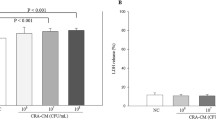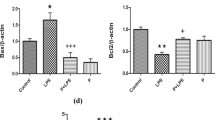Abstract
Exposure to environmental pollutant 1,2-dimethylhydrazine (DMH) is attributed to systemic oxidative stress and is known to cause neurotropic effect by altering brain neurotransmitter status. Probiotics are opted as natural therapeutic against oxidative stress and also have the ability to modulate gut–brain axis. Pyrroloquinoline quinone (PQQ) is water-soluble, heat-stable antioxidant molecule. Aim of the present study was to evaluate the antioxidant efficacy of PQQ-producing probiotic E. coli CFR 16 on DMH-induced systemic oxidative damage and altered neurotransmitter status in rat brain. Adult virgin Charles Forster rats (200–250 g) were given DMH dose (25 mg/kg body weight, s.c.) for 8 weeks. Blood lipid peroxidation levels exhibited a marked increase while antioxidant enzyme activities of superoxide dismutase, catalase, glucose-6-phosphate dehydrogenase and glutathione peroxidase were found to be reduced in DMH-treated rats. Likewise, brain serotonin and norepinephrine levels displayed a significant decrease, whereas epinephrine levels demonstrated a marked increase in brain of these rats. PQQ-producing E. coli CFR 16 supplementation reduced systemic oxidative stress and also restored brain neurotransmitter status. However, E. coli CFR 16 did not show any effect on these parameters. In contrast, E. coli CFR 16:: vgb–gfp and E. coli CFR 16:: vgb–gfp vector exhibited some degree of protection again oxidative stress but they were not able to modulate neurotransmitter levels. In conclusion, continuous and sustained release of PQQ by probiotic E. coli in rat intestine ameliorates systemic oxidative stress and restored brain neurotransmitter levels.


Similar content being viewed by others
References
Amaretti A, di Nunzio M, Pompei A, Raimondi S, Rossi M, Bordoni A (2013) Antioxidant properties of potentially probiotic bacteria: in vitro and in vivo activities. Appl Microbiol Biotechnol 97:809–817
Andersson KE, Wein AJ (2004) Pharmacology of the lower urinary tract: basis for current and future treatments of urinary incontinence. Pharmacol Rev 56:581–631
Arutjunyan AV, Kerkeshko GO, Anisimov VN, Stepanov MG, Prokopenko VM, Pozdeyev NV, Korenevsky AV (2001) Disturbance of diurnal rhythms of biogenic amines contents in hypothalamic nuclei as an evidence of neurotrophic effects of entrotropic carcinogen 1, 2-dimethylhydrazine. Neuro Endocrinol Lett. 22:229–237
Bercik P, Park AJ, Sinclair D, Khoshdel A, Lu J, Huang X, Deng Y, Blennerhassett PA, Fahnestock M, Moine D, Berger B, Huizinga JD, Kunze W, McLean PG, Bergonzelli GE, Collins SM, Verdu EF (2011) The anxiolytic effect of Bifidobacterium longum NCC3001 involves vagal pathways for gut-brain communication. Neurogastroenterol Motil 23:1132–1139
Bouayed J, Bohn T (2010) Exogenous antioxidants—double-edged sword in cellular redox state Health beneficial effects at physiologic doses versus deleterious effects at high doses. Oxid Med Cell Longev 3:228–237
Bravo JA, Forsythe P, Chew MV, Escaravage E, Savignac HM, Dinan TG, Bienenstock J, Cryan JF (2011) Ingestion of Lactobacillus strain regulates emotional behavior and central GABA receptor expression in a mouse via the vagus nerve. Proc Natl Acad Sci USA 108:16050–16055
Cerutti PA (1994) Oxyradicals and cancer. Lancet 344:862–863
Choi O, Kim J, Kim JG, Jeong Y, Moon JS, Park CS, Hwang I (2008) Pyrroloquinoline quinone is a plant growth promotion factor produced by Pseudomonas fluorescens B16. Plant Physiol 146:657–668
Collado MC, Bäuerl C, Martínez GP (2012) Defining microbiota for developing new probiotics. Microb Ecol Health Dis. doi:10.3402/mehd.v23i0.18579
Curzon G, Green AR (1970) Rapid method for the determination of 5-hydroxytryptamine and 5-hydroxyindoleacetic acid in small regions of rat brain. Br J Pharmacol 39:653–655
Dong XX, Wang Y, Qin ZH (2009) Molecular mechanisms of excitotoxicity and their relevance to pathogenesis of neurodegenerative diseases. Acta Pharmacol Sin 30:379–387
Eisenberg RC, Dobrogosz WJ (1967) Gluconate metabolism in Escherichia coli. J Bacteriol 93:941–949
Feng ZH, Lei WU, Ming LU, Yu-lin HU, Xiao H, Zheng-qiang L (2011) Structure characteristic and catalase activity of Vitreoscilla hemoglobin bound with membrane. Chem Res Chin Univ 27:450–454
Fiala ES, Kulakis C, Christiansen G, Weisburger JH (1978) Inhibition of the metabolism of the colon carcinogen, azoxymethane, by pyrazole. Cancer Res 38:4515–4521
Finkel T, Holbrook NJ (2000) Oxidants, oxidative stress and the biology of ageing. Nature 408:239–247
Genc S, Zadeoglulari Z, Fuss SH, Genc K (2012) The adverse effects of air pollution on the nervous system. J Toxicol. doi:10.1155/2012/782462
Ghosh NC, Deb C, Banerjee S (1951) Colorimetric determination of epinephrine in blood and adrenal gland. J Biol Chem 192:867–874
Gyaneshwar P, Kumar GN, Parekh LJ (1998) Effect of buffering on the phosphate-solubilizing ability of microorganisms. World J Microbiol Biotechnol 14:669–673
Harzallah JH, Grayaa R, Kharoubi W, Maaloul A, Hammami M, Mahjoub T (2012) Thymoquinone, the Nigella sativa bioactive compound, prevents circulatory oxidative stress caused by 1,2-dimethylhydrazine in erythrocyte during colon post initiation carcinogenesis oxidative medicine and cellular longevity. Oxid Med Cell Longev. doi:10.1155/2012/854065
Hou Y, Wang L, Zhang W, Yang Z, Ding B, Zhu H, Liu Y, Qiu Y, Yin Y, Wu G (2012) Protective effects of N-acetylcysteine on intestinal functions of piglets challenged with lipopolysaccharide. Amino Acids 43:1233–1242
Jacobowitz DM, Richardson JS (1978) Method for the rapid determination of norepinephrine, dopamine, and serotonin in the same brain region. Pharmacol Biochem Behav 8:515–519
Jellinger KA (2010) Basic mechanisms of neurodegeneration: a critical update. Cell Mol Med 14:457–487
Kovach ME, Elzer PH, Hill DS, Robertson GT, Farris MA, Roop RM, Peterson KM (1995) Four new derivatives of the broad-host-range cloning vector pBBR1MCS, carrying different antibiotic-resistance cassettes. Gene 166:175–176
Kumar P, Ferzin S, Chintan S (2009) isolation and characterization of potential probiotic Escherichia coli strains from rat faecal samples. Amer J Infect Dis 5:112–117
Kumar P, Ranawade AV, Kumar GN (2014) Potential probiotic Escherichia coli 16 harboring the Vitreoscilla hemoglobin gene improve gastrointestinal tract colonization and ameliorate carbon tetrachloride induced hepatotoxicity in rats. BioMed Res Int. doi:10.1155/2014/213574
Mathew CM, Ervin AM, Tao A, Davis RM (2012) Antioxidant vitamin supplementation for preventing and slowing the progression of age-related cataract. Cochrane Database Syst Rev 6:CD004567. doi:10.1002/14651858
Misra HS, Rajpurohit YS, Khairnar NP (2012) Pyrroloquinoline-quinone and its versatile roles in biological processes. J Biosci 37:313–325
Miyauchi K, Urakami T, Aabeta H, Shi H, Noguchi N, Niki E (1999) Action of pyrroloquinolinequinol as an antioxidant against lipid peroxidation in solution. Antioxid Redox Signal 1:547–554
Moro MA, Almeida A, Bolaños JP, Lizasoain I (2005) Mitochondrial respiratory chain and free radical generation in stroke. Free Radic Biol Med 39:1291–1304
Nutt D, Demyttenaere K, Janka Z, Aarre T, Bourin M, Canonico PL, Carrasco JL, Stahl S (2007) The other face of depression, reduced positive affect: the role of catecholamines in causation and cure. J Psychopharmacol 21:461–471
Pandey S, Ashish S, Kumar P, Chaudhari A, Nareshkumar G (2014) Probiotic Escherichia coli CFR 16 producing pyrroloquinoline quinone (PQQ) ameliorates 1,2-dimethylhydrazine-induced oxidative damage in colon and liver of rats. Appl Biochem Biotechnol 173:775–786
Spencer JP, Jenner P, Daniel SE, Lees AJ, Marsden DC, Halliwell B (1998) Conjugates of catecholamine with cysteine and GSH in Parkinson’s disease: possible mechanisms of formation involving reactive oxygen species. J Neurochem 77:2112–2122
Uttara B, Singh AV, Zamboni P, Mahajan RT (2009) Oxidative stress and neurodegenerative diseases: a review of upstream and downstream antioxidant therapeutic options. Curr Neuropharmacol 7:65–74
Wrona MZ, Dryhurst G (1998) Oxidation of serotonin by superoxide radical: implications to neurodegenerative brain disorders. Chem Res Toxicol 11:639–650
Yang W, Omaye ST (2009) Air pollutants, oxidative stress and human health. Mutat Res 674:45–54
Acknowledgments
Mr. Ashish Singh was supported by CSIR-JRF, Government of India.
Author information
Authors and Affiliations
Corresponding author
Rights and permissions
About this article
Cite this article
Pandey, S., Singh, A., Chaudhari, N. et al. Protection Against 1,2-Di-methylhydrazine-Induced Systemic Oxidative Stress and Altered Brain Neurotransmitter Status by Probiotic Escherichia coli CFR 16 Secreting Pyrroloquinoline Quinone. Curr Microbiol 70, 690–697 (2015). https://doi.org/10.1007/s00284-014-0763-9
Received:
Accepted:
Published:
Issue Date:
DOI: https://doi.org/10.1007/s00284-014-0763-9




